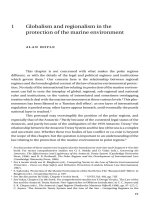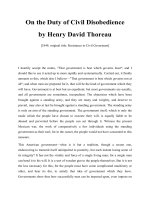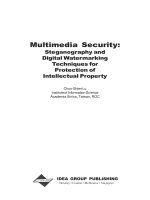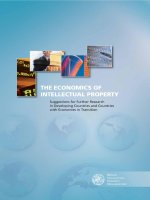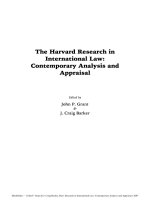The Protection of Biodiversity and Traditional Knowledge in International Law of Intellectual Property pot
Bạn đang xem bản rút gọn của tài liệu. Xem và tải ngay bản đầy đủ của tài liệu tại đây (2.04 MB, 361 trang )
This page intentionally left blank
The Protection of Biodiversity and
Traditional Knowledge in International
Law of Intellectual Property
The relationships between international intellectual property treaties,
the United Nations international environmental treaties (first and fore-
most the convention on Biological Diversity), the relevant customary
norms and soft law form a complex network of obligations that some-
times conflict with each other. The first set of treaties creates private
rights while the latter affirms the sovereignty rights of States over genetic
resources and related knowledge and creates international regimes of
exploitation of the same.
Jonathan Curci proposes solutions to the conflicts between treaties
through the concept of “mutual supportiveness,” including the construc-
tion of a national-access and benefit-sharing regime, mandatory contrac-
tual provisions in relevant international contracts, a defensive protection
when genetic-resource-related traditional knowledge is unjustly patented
through the analysis of the concepts of “ordre public and morality,”
“certificate of origin” in the patent application and “novelty-destroying
prior art” and positive protection through existing and sui generis intel-
lectual property rights and misappropriation regimes.
jonathan curci is the Legal Counsel of Quantam Business Group,
Ltd, Israel and Academic Counsel of Touro International University,
Rome.
Cambridge Intellectual Property and Information Law
As its economic potential has rapidly expanded, intellectual property
has become a subject of front-rank legal importance. Cambridge
Intellectual Property and Information Law is a series of monograph studies
of major current issues in intellectual property. Each volume contains a
mix of international, European, comparative and national law, making
this a highly significant series for practitioners, judges and academic
researchers in many countries.
Series editor
WILLIAM R. CORNISH
Emeritus Herchel Smith Professor of Intellectual Property Law,
University of Cambridge
LIONEL BENTLY
Herchel Smith Professor of Intellectual Property Law,
University of Cambridge
Advisory editors
FRANÇOIS DESSEMONTET
Professor of Law, University of Lausanne
PAUL GOLDSTEIN
Professor of Law, Stanford University
THE RT HON. SIR ROBIN JACOB
Judge of the Court of Appeal, England
A list of books in the series can be found at the end of this volume.
The Protection of Biodiversity
and Traditional Knowledge in
International Law of
Intellectual Property
Jonathan Curci
CAMBRIDGE UNIVERSITY PRESS
Cambridge, New York, Melbourne, Madrid, Cape Town, Singapore,
São Paulo, Delhi, Dubai, Tokyo
Cambridge University Press
The Edinburgh Building, Cambridge CB2 8RU, UK
First published in print format
ISBN-13 978-0-521-19944-5
ISBN-13 978-0-511-76991-7
© Jonathan Curci 2010
2009
Information on this title: www.cambridge.org/9780521199445
This publication is in copyright. Subject to statutory exception and to the
provision of relevant collective licensing agreements, no reproduction of any part
may take place without the written permission of Cambridge University Press.
Cambridge University Press has no responsibility for the persistence or accuracy
of urls for external or third-party internet websites referred to in this publication,
and does not guarantee that any content on such websites is, or will remain,
accurate or appropriate.
Published in the United States of America by Cambridge University Press, New York
www.cambridge.org
eBook (NetLibrary)
Hardback
Contents
List of abbreviations page vii
Acknowledgments xi
Part I The main problems 1
1 Introduction to legal issues related to genetic resources and
traditional knowledge in the international intellectual
property system 3
1.1 Defining the problems 4
1.2 Some methodological aspects 17
Part II The protection of genetic resources in intellectual
property law 27
2 The TRIPS Agreement and the patent protection of genetic
resources 29
2.1 The general principles of the TRIPS Agreement 29
2.2 The patentability of biotechnology 36
2.3 Economic considerations on biotech-patents and their interaction
with traditional knowledge 42
2.4 Conclusion 48
3 The relationship between the TRIPS Agreement and
treaties protec ting genetic resources and traditional
knowledge 50
3.1 The impact of the TRIPS Agreement on CBD obligations 51
3.2 The impact of UPOV on the freedom of exchange of seeds 62
3.3 Some international intellectual property aspects of the FAO
ITPGRFA 62
3.4 Conclusion of Part II 85
v
Part III The protection of traditional knowledge in the
international patent system 87
4 Towards clearer legal definitions 91
4.1 An intellectual property approach to the concept of traditional
knowledge 91
4.2 A few relevant analytical distinctions on biodiversity and related
traditional knowledge 95
5 The construction of an access- and benefit-sharing regime
and intellectual property issues: criteria and options 103
5.1 The CBD mandated access- and benefit-sharing regime 104
5.2 An access- and benefit-sharing regime and the contractual solution 105
6 The defensive protecti on of traditional knowledge in
international patent law 131
6.1 The certificate on the disclosure of origin/source 132
6.2 Traditional knowledge as prior art 208
6.3 Ordre public and morality as exception to patentability 233
7 Positive protection of traditional knowledge 275
7.1 Positive protection of plant genetic resources and related traditional
knowledge in provider countries 275
7.2 Protecting traditional knowledge through the implementation of
Article 27.3(b) of TRIPS 277
7.3 The creation of new intellectual property rights for plant genetic
resources related to traditional knowledge 285
7.4 The protection of traditional knowledge through unfair competition 304
7.5 Trade secrets 311
7.6 Applying patent law to traditional knowledge innovation 313
7.7 Overview on the utility of geographical indications and trademarks 315
8 Final observations 326
Index 334
vi Contents
List of abbreviations
ABS access and bene fit sharing
ACP African Caribbean Pacific
AIPLA American Intellectual Property Law Association
AIPPI Association internationale pour la protection de la
propriété intellectuelle
ARIPO African Regional Industrial Property Organization
ATRIP International Association for the Advancement of
Teaching and Research in Intellectual Property
CAF Corporación Andina de Fomento
CBD Convention on Biological Diversity
CBE Convention sur le brevet européen
CFR Code of Federal Regulations
CGIAR Consultative Group on International Agricultural
Research
CGRFA Commission on Genetic Resources for Food and
Agriculture
CHM clearing house mechanism
CIEL Center for International Environmental Law
CIT Court of International Trade
CLR compulsory liability regim e
CNRS Centre nationale de la recherche scientifique
COP Conference of the Parties
CPGRFA Commission on Plant Genetic Resources for Food
and Agriculture
CRADA Cooperative Re search and Development Agreement
CSD Commission on Sustainable Developme nt
CSIR Council for Scientifi c and Industrial Research
DC/DCs developing country/developing countries
DDAGTF Doha Development Agenda Global Trust Fund
DNA deoxyribonucleic acid
DSB dispute settlement body
DSU dispute settlement understanding
vii
EC European Community
ECHR European Convention of Human Rights.
ECJ European Court of Justice
ECOSOC United Nations Economic and Social Council
EPC European Patent Convention
EPO European Patent Office
EU European Union
FAO Food and Agriculture Organization
FTA free trade agreement
FTC Federal Trade Commission
GAOR General Assembly Official Records
GATT General Agreement on Tariffs and Trade
GIs geographical indications
GMO genetically modified organism
GNU general public license
GPA Global Programme of Action for the Protection of the
Marine Environment from Land-based Activities
GR/GRs genetic resource(s)
GRAIN Genetic Resources Action International
GRULAC Group of Countries of Latin America and the
Caribbean
HIV human immunodeficiency virus
IAO Instituto Agronomico per l’Oltremare
ICANN Internet Corporation for Assigned Names and
Numbers
ICESCR International Covenant on Economic, Social and
Cultural Rights
ICJ International Court of Justice
ICTSD International Centre for Trade and Sustainable
Development
IGC intergovernmental committee
ILA International Law Association
ILC International Law Commission
ILM International Legal Mat erials
ILO International Labor Organization
INBio Costa Rican National Biodiversity Institute
INDECOPI Instituto Nacional de Defensa de la Competencia y de
la Protección de la Propiedad Intelectual
IP intellectual property
IPGRI Internati onal Plant Genetic Resources Institute
viii List of abbreviations
IPGRTKF intellectual property and genetic resources,
traditional knowledge and folklore
IPR intellectual property right
ITPGRFA International Treaty on Plant Genetic Resources for
Food and Agriculture
IUCN The World Conservation Union
IUPGR international undertaking on plant genetic resources
LDC least developed country
MEA multilateral environment agreement
MFN most favored nation
MNC multinational corporation
MTA material transfer agreement
NAFTA North American Free Trade Agreement
NGO non-governmental organization
NIF national innovation fund
OAU Organization of African Unity
OEB Office européen des brevets
OECD Organization for Economic Cooperation and
Development
OSD open source definition
OSI open source initiati ve
PBR plant breeders’ right
PCIJ Permanent Court of International Justice
PCT Patent Cooperation Treaty
PGM plant genetic material
PGR/PGRs plant genetic resource(s)
PGRFA plant genetic resources for food and agriculture
PGS plant genetic systems
PIC prior informed consent
PLO Palestine Liberation Organization
PLT Patent Law Treaty
PVP plant variety protection
R&D research and development
RAFI Rural Advancement Foundation International (now
Action Group on Erosion, Technology and
Concentration, ETC Group)
RNA ribonucleic acid
RSA Recueil des sentences arbitrales
SAA Round Statement for Administrative Action
SAARC South Asian Association for Regional Cooperation
SADC Southern Africa Development Community
List of abbreviations ix
SCP Standing Committee Law of Patents
SINGER System-wide Information Network for Genetic
Resources
SPLT Substantive Patent Law Treaty
SPS Sanitary and Phytosanitary Measures
SRISTI Society for Research and Initiative s for Sustainable
Technologies and Institution
TAK traditional agri cultural knowledge
TEK traditional ecological knowledge
TIPR/TIPRs traditional intellectual property right(s)
TK traditional knowledge
TKUP traditional knowledge of the uses of plants
TMK traditional medicinal knowledge
TRIPS Agreement on Trade-Related Aspects of Intellectual
Property
UDHR Universal Declaration on Human Rights
UNCTAD United Nations Conference on Trade and
Development
UNEP United Nations Environment Program
UNESCO United Nations Educational, Scientific and Cultural
Organization
UNFOF United Nations Forum on Forests
UNHCR United Nations High Commissioner for Human
Rights
UNTS United Nations Treaty Series
UPOV Union internationale pour la protection des
obtentions végétales (International Union for the
Protection of New Varieties of Plants)
URAA Uruguay Round Agreements Acts
USPTO United States Patent and Trademark Office
VCLT Vienna Convention on the Law of Treaties
WHO World Health Organization
WIPO World Intellectual Property Organization
WIPO IGC on
IPGRTKF
Intergovernmental Committee on Intellectual
Property and Genetic Resources, Traditional
Knowledge and Folklore
WSSD World Summit on Sustainable Development
WTI World Trade Institute
WTO World Trade Organization
x List of abbreviations
Acknowledgments
The present work is based on a doctoral dissertation deposited at the
Library of the Graduate Institute of International and Development
Studies University in Geneva (Switzerland) that is much richer in terms
of footnotes and legal reasoning because broader in scope than the present
book. I thank the University of Torino (Italy) and the Brigham Young
University in Provo, Utah (United States of America) for providing the
necessary education, their libraries and work place to draft this work. I
owe a special thanks to the Research Fund of the European Patent Office
(EPO) for the grant that has allowed me to carry on this work under more
comfortable conditions.
I wish to express my gratitude to the supervisor of the underlying
doctoral work Marcelo Kohen (Professor of International Law at the
Graduate Institute of International Studies in Geneva, Switzerland),
Thomas Cottier (Director of the World Trade Institute – WTI – at the
University in Berne, Sw itzerland) and Marco Ricolfi (Professor of
Intellectual Property at the Law School of the University of Turin,
Italy). Their extensive expertise in the technical aspects of the new and
cutting-edge topic of international trade law and the opportunities each of
them were able to offer me as a researcher or consultant on projects under
their direction provided me with invaluable experience, as well as much-
needed motivation.
I also wholeheartedly thank Dr. Anthony Taubman, Acting Director
and Head of the WIPO Global IP Issues Division, and Dr. Shakeel Bhatti,
former Head of the WIPO Genetic Resource Traditional Knowledge and
Biotechnology Section. A special thanks to my friends Daniel Stewart
(Attorney-at-Law), David Newell and Peter Bradford (Patent Attorney)
for having thought, discussed and researched with me related topics in our
professional and research projects.
A very special thanks for the linguistic insights and corrections by
Alison Craig and William Marconi.
xi
Part I
The main problems
1 Introduction to legal issues related to genetic
resources and traditional knowledge in the
international intellectual property system
In the new millennium, biotechnology is enabling genetic engineering to
yield very important breakthroughs, with immense possibilities for novel
organisms to be developed. The myriad biotechnological applications
released into the environment for pharmaceutical, agricultural, and
medicinal purposes generate transnational concerns that pose an enor-
mous challenge to national and international communities. The means of
protection sought for these types of inventions is the patent. Although
opinions about how much patent systems contribute to long-term eco-
nomic growth vary, there can be no dispute that patents are vital to the
business models of many companies and are playing an increasing role in
society. As human technological prowess has expanded throughout the
natural and hum an worlds, the patent has followed, not far behind.
Questions about the proper place of patents in society, some old and
some new, have found increasing urgency and importance, especially as
patent law extends to societies not accustomed to its peculiarities.
Peoples in developing countries (DCs) denounce the patentability of
genes, which reduces the world’s genetic resources (GRs) down to mere
property rights, resulting in corporate control over access to food, medic-
inal technology, and other resources essential to mankind’s health and
welfare. Additionally, potential transnational harm caused by genetic
engineering may also arise through the destabilization of regional ecolo-
gies via genetic pollution and through an accelerated decline of biological
diversity on a global scale. Thus, legal control over biodiversity is an issue
of serious international consequence.
The present book focuses particularly on the international legal regime
of commercial exploitation and ownership of GRs, on which biotechno-
logical innovation is based. At the core of this study lies the problems of
sharing benefits arising from the exercise of intellectual property rights
(IPRs) over plant genetic resources (PGRs) and traditi onal knowledge
(TK) under existing treaties and conventions with special attention to the
contractual relations between companies from industrialized countries
and indigenous communities and genetic resource providing countries.
3
Although this analysis is conducted t hrough an international law approach,
it does not neglect some anthropological and sociological aspects of private
ownership of living forms and its interaction with different value systems.
1.1 Defining the problems
This chapter starts with general considerations on the problem of owner-
ship and patents on PGRs; in a second stage, it observes the interaction
among the international public domain, the States’ sovereign rights over
PGRs and private IPRs over the same, and ultimately introduces the new
problem of traditional knowledge (TK).
It lays out the methodological aspects of the analysis and presents a brief
overview of the theories of creation of the sources of international law that
are relevant to this subject-matter and that will be used through the
development of analysis. Accordingly, the impact of international law,
with particular attention to World Trade Organization (WTO) law, shall
be taken into account in a comparative approach. Because the European
Union (EU) and United States (US) jurisdictions have developed various
laws, policies and judicial decisions on the relationship between protec-
tion of biodiversity and intellectual property they offer broad examples of
implementation of international law that are worthy to be described and
discussed when appropriate.
1.1.1 Patents and ownership of genetic resources
The patentability of biotechnology took off after the US Supreme Court’s
landmark decision in Diamond v. Chakrabarty.
1
By acknowledging that statu-
torily patentable subject-matter included “anything under the sun that is
made by man,” the Court encompassed both fore seeable and unforeseeable
subject-matter. This Diamond standard encompassed the inventive work of
biotechnology and gene sequences. Consequently, an “imitation effect”
rippled from the US to Europe and other jurisdictions, generating a series
of legislative measures to patent living forms. In addition, the WTO
Agreement on Trade-Related Aspects of Intellectual Property Rights
2
1
Diamond v. Chakrabarty, 447 United States, 303–09 (1980), reported also in F. Abbott,
T. Cottier and F. Gurry (eds.), The Intellectual Property System: Commentary and Materials
(Kluwer, The Hague, 1999) 25.
2
Agreement on Trade-Related Aspects of Intellectual Property Rights (April 15, 1994)
Marrakesh Agreement Establishing the World Trade Organization, Annex 1C, Legal
Instruments – Results of the Uruguay Round 31–33 International Legal Materials (ILM)
1197 (1994).
4 Intellectual property, biodiversity and traditional knowledge
(TRIPS) internationalized the patent p rotection of biotechnological
practices.
In industrialized societies, investment and innovative output in the
biotechnology industry has been so conspicuous that the benefits of
innovation in this field have generall y been viewed as outweigh ing the
costs of the monopolistic restrictions created by patents. Now, not only
plant varieties but also micro-organisms and genetically modified animals
are patentable. Genetically altered animals, such as the infamous Onco-
Mouse of Harvard University (bred for cancer research), have also been
given patents. Thousands of patent claims have been made and granted
on human genetic material, including material that has arguably been
altered from its natural state.
The patent is the primary IPR that is sought in the field of biotechnology
because it is meant to be a right concerning innovations used in new or
improved products or processes. Patents enable the holder to exclude
imitators from marketing such inventions or processes for a specified
time; in exchange, the holder is required to disclose the formula or idea
behind the product or process. After a patent is granted, the owner has a
monopoly over commercial exploitation of the invention for a limited
period. The stated purpose of a patent is to sti mulate innovation by
offering higher monetary returns than the market otherwise might
provide.
3
There are two problems that patent protection generates. The first
concerns the monopolistic feature of the cost analysis of patent protection
in this field. The classical IP scholarship has crafted each protection
according to the principle of “allocative ef ficiency” according to which
the long-term benefits flowing to society from the protection granted to a
particular class of creators or innovators outweigh the (mainly short-term)
costs imposed by the monopolistic structure of the patent grant.
4
And the
“mainstream legal literature” has applied this standard principle from IP
economics to the patenting of biotechnology as well .
5
The second problem is generated when formal, industrial, patentable
knowledge builds upon prior art of informal TK which is in a q uasi-commons
3
Abbott et al., The Intellectual Property System, 25.
4
P. Torremans and J. Holyoak, Intellectual Property Law (Oxford University Press, 2006) 16,
20. N. Carvalho, “From the Shaman’s Hut to the Patent Office: How Long and Winding is
the Road?” (1999) 40 Revista da ABPI 3–28. R. H. Coase, The Firm, the Market and the Law
(University of Chicago Press, revised edition, 1990), see chapters 1 and 2 “The Firm, The
Market, and The Law” and “The Nature of the Firm.”
5
Which includes, in the European literature in the bibliography quoted in M. Ricolfi,
“Biotechnology, Patents and Epistemic Approaches” (2002) Journal of Biolaw &
Business, Special Supplement 77–90.
Introduction to legal issues 5
regime. When it comes to the benefit sharing of the profits arising from the
exploitation of this knowledge at the international level these problems are
amplified.
A vivid example of benefit sharing illustrates the controversy of private
property rights in GRs based on TK held by indigenous groups. Imagine a
plant that produces a natural sweetener and has been preserved for several
millennia in a local farming micro-culture. This sweetener performs its
sweetening function without negative dietary or health side effects. A
foreign corporation comes along bioprospecting and secures samples of
the local sweetening plant, maps its genome, and then proceeds to genet-
ically engineer a plant that yields sweetener with a potency tenfold that of
the original. The corporation then patents the modified plant, and the
world quickly forgets the original plant as the patented plant is markedly
more productive. Consequently, through commercialization, all of the
profits flow to the company patent holder without a farthing going to the
indigenous farmers who preserved the plant for millennia. Some 6.5
percent of all genetic research undertaken in agriculture focuses on
germ plasma derived from wild species and land races (farmer-developed
varieties of crop plants that are adapted to local environmental condi-
tions). Thus, the question is posed: is it fair to give the entire pastry to the
one who adds the final cherry to the pie?
6
This tendency has been popularly called biopiracy or biocolonialism.The
origin of the two terms reveals that the context in which they were formed
is the one of political science or sociology. These are not legal terms,
let alone technical intellectual property terms. Th e term biopiracy was
coined by Mooney as part of a counter-attack strategy on behalf of DCs
that, as already said, are accused by industrialized countries of supporting
intellectual piracy, i.e., counterfeiting all types of goods protected in the
industrialized countries by IPRs. In turn, DCs feel that they are no more
pirates than corpora tions that acquire resources and TK from their coun-
tries, use them in their Research and Development programs, and acquire
patents and other IPRs without compensating the provider countries and
communities.
7
This anti-biopiracy rhetoric adopted by some DC trade
6
Ricolfi, “Biotechnology, Patents and Epistemic Approaches”, 77; T. Cottier, “The
Protection of Genetic Resources and Traditional Knowledge: Towards More Specific
Rights and Obligations in World Trade Law”, in Abbott et al., The Intellectual Property
System 1820–27; M. Blakeney, Presentation at the World Intellectual Property
Organization (WIPO) – Torino Law School Specialization Course in Intellectual
Property, International Property Aspects of Traditional Agricultural Knowledge (TAK)
2 (Nov. 22, 2001), unpublished, on file with the author.
7
R. Mooney, “Why I Call It Biopiracy”, in H. Svarstad and Sh. S. Dhillion (eds.),
Responding to Bioprospecting: From Biodiversity in the South to Medicines in the North
6 Intellectual property, biodiversity and traditional knowledge
negotiators has not prevented the legalization of this so-called “conquest”
through the TRIPS Agreement. This treaty extends to all the developing
and least developed members of the WTO the obligation to g rant IPRs
(patents, trademarks, and trade secrets, etc.), and, to some extent, also to
innovations based on GRs, without m andating any compensation to the
local communities who have bred and preserv ed these resources. At the
same time, some 90 percent of genetic informa tion and related TK are
found in DCs.
8
Biocolonialism is another term related to biopiracy and it often refers to
the pattern whereby the industrialized country corporation extracts raw
genetic materials from the DC, patents the genetically modified products
based on the raw materials without prior informed consent (PIC) and
benefit sharing, and then sells the finished product to the provider country
at unaffordably high prices. In addition to these perceptions of injustice
and misappropriation, the wide scope of the exclusive patent rights
granted in industrialized countries stirs animosity on the part of the
consumers in DCs, especially when the patent itself is based on a GR or
TK preserved by the consumers of the patented product in DCs.
Even part of the legal doctrine has been vociferously arguing that IP
regimes may jeopardize the freedom of countries or communities to
choose the way in which they want to deal with the use and protection of
biodiversity and the related TK. This issue blatantly arises when the genes
are not appropriated by the sovereign State that patents them but by a
foreign entity that manipulates and sells the genetically modified product.
As a consequence of the double expansion of patent law both from
inanimate to animate subject-matter (biotechnological inventions) and
from a small group of industrialized countries to most of developing and
Least Developed Countries (LDCs), several peoples in DCs are reacting
against this kind of “piracy” of indigenous and local community
knowledge.
These are some of the reasons for which peoples in DCs allege that IPRs
in the field of biotechnology could prevent the Convention on Biological
Diversity (CBD) from realizing the full and practical meaning of Article 3
9
on national sovereignty over their natural resources and Article 8(j)
10
on
(Spartacus Press, AS., Oslo, 2000) 37; V. Shiva, Biopiracy: the Plunder of Nature and
Knowledge (South End Press, 1998) 1–5; A. Story, “Biopiracy and the Dangers of Patent
Over-protection”, (1999) 149 New Law Journal 158.
8
Cottier, “The Protection of Genetic Resources”, in Abbott et al., The Intellectual Property
System, 1827.
9
Article 3 of the CBD, Convention on Biological Diversity (June 5, 1992) UNEP/Bio.Div/
N7-INC5/4, 31 ILM 818 (1992).
10
WIPO, Intellectual Property Needs and Expectations of Traditional Knowledge Holders: WIPO
Fact Finding Missions on Intellectual Property and Traditional Knowledge (WIPO, Geneva,
Introduction to legal issues 7
the rights of local and indigenous communities. These provisions aim at
fairly distributing the benefits resulting from the use of GRs situated in the
territories of the Contracting Parties.
Industrialized countries respond by affirming their effort to develop
technology enabling the modification, the innovation, and the market-
ability of raw genetic materials that otherwise would remain unexploited
within developing country indigenous communities that do not have such
capacities. The debate is acrimonious and solutions are not easily at hand.
1.1.2 International public domain, sovereign rights, and intellectual property
rights over genetic resources
This section moves from the general concept of ownershi p of GRs to the
conflict between a State’s public law regime of exercise of sovereignty
rights upon GRs and then to the private exercise of IPRs upon the same.
The international exercise of patent rights has an impact both on the
ownership regime over the GR per se and on the knowledge of the uses for
and the characteristics of plant and animal GRs. Biotechnology depends
on biological diversity as the basis of innovation. The access to biological
diversity in a given country has traditionally been free and open. This led
to the basic inequity (already sketched in section 1.1 above) consisting of
the freedom of appropriation of GR and of TK on the part of the inventor
on one side, while on the other the users in the country in question had to
purchase the secondary products subjected to proprietary protection .
Profits flow into the hands of right-holders in industrialized countries
for the exploitation of biodiversity and related knowledge in DCs.
For example, suppose a researcher were to incorporate into his studies
TK that had been generated by a particular community over hundreds of
years and not attributable to any particular person. As far as the researcher
is concerned, the TK used in his research is, for all intents and purposes,
public domain knowledge. Suppose further that the researcher subse-
quently reports this knowledge with or without acknowledging the intel-
lectual contributions of the initial TK holding community. Should that
information ever prove useful in the creation of a patentable good, i.e. the
creation of a drug through use of TK on a particular medicinal plant,
the community would be without recourse to claim ownership or rights
in the TK at the heart of the innovation, merely because that TK was
2001) 50. T. Taubman, “Genetic Resources” in S. Von Lewinski, Indigenous Heritage and
Intellectual Property: Genetic Resources, Traditional Knowledge and Folklore (Kluwer, The
Hague, 2nd edn, 2008) 192–216.
8 Intellectual property, biodiversity and traditional knowledge
within the public domain at the time it was recorded. Meanwhile, the
company owning the patent exclusively reaps all the commercial benefits.
In the systems of protection of IP in industrialized countries, TK
related to GRs has until recently been considered as international public
domain because of the confusion of the public domain with the interna-
tional legal concept of res communis humanitatis (common heritage of
mankind).
11
The assimilation of TK into res communis humanitatis was
necessary to justify the free accessibility of TK to all private users.
12
While
the concept of res communis humanitatis covers the ocean floor,
13
Antarctica,
14
the moon,
15
and outer space,
16
it is doubtful, in my view,
whether biodiversity in general should be placed under the concept of
common heritage of mankind, stricto sensu.
17
There is no treaty or custom-
ary principle
18
that places TK and GRs under the concept of res communis
humanitatis. On the contrary, starting from the colonial era, coloni al states
used to transfer GRs to their masters as contributions to their research
centers.
19
The international community finally discussed the position of GRs in
international law during negotiation of the CBD adopted in 1992. At the
start of the negotiations, the legal status of GRs in situ and ex situ was very
11
C. Joyner, “Legal Implications of the Concept of the Common Heritage of Mankind”,
(1986) 35 International and Comparative Law Quarterly 190; R. Wolfrum, “The Principle
of the Common Heritage of Mankind” (1983) 43 Zeitschrift für ausländisches öffentliches
Recht und Völkerrecht, Heidelberg Journal of International Law 312.
12
Matter Concerning Intellectual Property and Genetic Resources, Traditional Knowledge and
Folklore – an Overview, WIPO/kritf/IC1/3, 8–9 (March 16, 2001).
13
J. Van Dyke and C. Yuen, “Common Heritage v. Freedom of the Seas: Which Governs
the Seabed?” (1982) 19 San Diego Law Review 493.
14
F. Francioni and T. Scovazzi (eds.), International Law for Antarctica (Kluwer, The Hague
1996); F. Francioni, International Environmental Law for Antarctica (Giuffrè, Milano,
1992); C. Joyner, “Antarctica and the Law of the Sea: Rethinking the Current Legal
Dilemmas” (1981) 18 San Diego Law Review 415.
15
K. Baslar, The Concept of the Common Heritage of Mankind in International Law (Martinus
Nijhoff, The Hague, 1998) 307–13. C. Christol, “The Common Heritage of Mankind
Provision in the 1979 Agreement Governing the Activities of States on the Moon and
Other Celestial Bodies”, (1980) 14 International Lawyer 429.
16
P. P. C. Hannapel, The Law and Policy of Air Space and Outer Space: a Comparative
Approach (Kluwer, The Hague, 2003); L. Tennen, “Outer Space: A Preserve for All
Humankind”, (1979) 1 Houston Journal of International Law 145.
17
I. Mgbeoji, “Rethinking the Role of International Law in Relation to the Appropriation of
Traditional Knowledge of the Uses of Plants” 132, 139, 148, 150, 159, 161, 163–70, 179,
252, 253 (a dissertation submitted for the Degree of Doctor in the Science of Law,
Dalhousie University Halifax, November 2001. Copy on file with author).
18
A. D’Amato, “Trashing Customary International Law in Appraisals of the ICJ’s Decision:
Nicaragua v. United States”, (1987) 81 American Journal of International Law 74–75;
M. S. McDougal, H. D. Lasswell, and M. Reisman, “The World Constitutive Process of
Authoritative Decision”, (1967) 19 Journal of Legal Education 403.
19
I. Mgbeoji, “Rethinking the Role”, 163–70.
Introduction to legal issues 9
unclear: few national laws had been enacted for the commercial exploita-
tion of the GRs in situ and no real international status had been created
for the gene banks conserving germplasm
20
ex situ (see in more detail
section 4.2.3 below). Ex situ collections of GRs could be acquired freely;
no international obligations existed to share the economic benefits to the
communities that provided and conserved the resources, and only very
few international breeding programs were set up to develop and distribute
crop varieties for use in the DCs.
21
The status of GRs in international law started to be clarified with the
adoption of a United Nations (UN) General Assembly Resolution 1830
(XVII) on 4 December 1962. At that time, the international community
focused its efforts on the preservation of biological diversity and on its
related knowledge under threat of extinction. Meanwhile, the slow proc-
ess of globalization of IPRs was considered a successful tool in protecting
and encouraging the further development of so-called “modern,”
“formal,” or “technological” knowledge applied to GRs (see the relevant
distinctions of TK in section 4.2 below). TK holders, especially in DCs,
had felt that this knowledge, passed on from generation to generation, had
progressively become an “economic resource.” The increasing pace of
exploitation of this knowledge through modern technological instruments
led the international community to shift the focus of its attention from the
“preservation” of GRs to their “utilization.” Rapidly, various interna-
tional fora became involved in the regulation of this matter: United
Nations Environmental Program (UNEP), World Intellectual Property
Organization (WIPO), United Nations Educational, Scientifi c and
Cultural Organization (UNESCO), International Lab our Organization
(ILO), United Nations Conference on Trade and Development
(UNCTAD), etc.
22
One of the most important highlights in the chronological development
of international public policy on this matter occurred in 1989, when the
United Nations Food and Agriculture Organization (FAO) enacted the
International Undertaking on Plant Genetics Resources (IUPGRs),
which originally defined PGRs as the “heritage of mankind which should
be available without restriction.” In other words it considered the germ-
plasm collected ex situ in gene banks as “common heritage of mankind.”
20
Germplasm is genetic material extracted from a plant.
21
M. Hassemer, “Genetic Resources” in S. Von Lewinski (ed.), Indigenous Heritage and
Intellectual Property: Genetic Resources, Traditional Knowledge and Folklore (Kluwer, The
Hague, 2004) 159–60.
22
See Table 1 “The Overview of the Regulatory Framework”, in T. Taubman and
M. Leistner, “Analysis of Different Areas of Indigenous Resources” in Von Lewinski,
Indigenous Heritage and Intellectual Property (2nd edn, 2008) 200–1.
10 Intellectual property, biodiversity and traditional knowledge
This concept was maintained in the IUPGRs of the FAO until 2001
(see section 3.3 below) when the international community adopted the
FAO International Treaty on Plant Genetic Resources for Food and
Agriculture (ITPGRFA) that facilitated access to a database of PGRs
held in trust by a Multilateral System for specific purposes of utilization.
23
This treaty thus establishes PGRs in a combination of a regime of State
sovereignty and a regime of multilateral cooperation, although nowhere in
the ITPGRFA is this concept explicitly stated.
The legal status of the rest of the biodiversity was defined by the CBD
adopted by the UNEP in 1992. In its preamble, it is stated that the preser-
vation of biodiversity is a “common concern o f humankind,” whereas, in its
Articles 3 and 15.1, it acknowledges the principle of permanent sovereignty
of the States o ver their natural resources on their territories. T his means that
access to G Rs has to be regulated by a private law contract, a so-called
“material transfer agreement” (MTA) involving the provider State and bio-
prospecting entity (see chapter 5). The i nternational community has moved
from this bilateral-contractual solution envisaged by the CBD to a clarifica-
tion of the concept of “common concern of humankind” as it relates to the
conservation and sustainable exploitation of PGRs.
Finally, the WIPO General Assembly, in creating in 2000 the
Intergovernmenta l Committee on Intellectual Property and Genetic
Resources, Traditional Knowledge and Folklore (WIPO IGC on
IPGRTKF) has started a new era of diplomatic discussions on the inter-
action among IP, GRs and TK. This IGC, supported by a Secretariat of
technical experts in the field, is paving the way for the negotiation and
adoption of a treaty which should clarify the relationship between private
rights of intellectual property and TK.
1.1.3 Introduction to the tensions between the exercise of intellectual
property rights and preservation of genetic resources
Six months after the CBD entered into force, WTO Members adopted the
TRIPS Agreement in 1994
24
that marked the commencement of a new
era of globalization of IPRs.
25
This treaty mandates minimum standards
of private property protection of all types of “formal” or “modern knowl-
edge,” including knowledge developed from GRs. Since then IP scholars
have intensely studied the ability of TRIPS-mandated IPRs to protect TK
related to GRs, taking into account the parallel evolution of non-IP
treaties (e.g. CBD and ITPGRFA). Indeed States’ obligations under
23
www.fao.org/Legal/treaties/033t-e.htm, last viewed November 2007.
24
TRIPS.
25
As of January 2007 there are 150 Member States in WTO.
Introduction to legal issues 11
